Transport in Cuba
Transportation in Cuba is the system of railways, roads, airports, waterways, ports and harbours in Cuba:
Railways

- total: 8,285 km
- standard gauge: 8,125 km 1,435 mm (4 ft 8 1⁄2 in) gauge (105 km electrified)
- narrow gauge: 160 km of 2 ft 3 1⁄2 in (699 mm) gauge.[1]
Cuba built the first railway system in the Spanish empire, before the 1848 start in the Iberian peninsula. While the rail infrastructure dates from colonial and early republican times, passenger service along the principal Havana to Santiago corridor is increasingly reliable and popular with tourists who can purchase tickets in Cuban convertible pesos. As with most public transport in Cuba, many of the vehicles used are second hand.
With the order of 12 new Chinese locomotives in 2006, built specifically for Cuban Railways at China Northern Locomotives and Rolling Stock Works, services have been improving in reliability. Those benefiting the most are long-distance freight services with the French train Havana-Santiago being the only passenger train using one of the new Chinese locomotives regularly. Various orders are in place for 100 locomotives from China and various freight wagons and passenger coaches.
In 2019, the Cuban railways received the first delivery of new Chinese-built coaches, and new services with these began in July 2019.[2][3]
Metro systems are not present in the island, although a suburban rail network exists in Havana.[4] Urban tramways were in operation between 1858 and 1954, initially as horse-drawn systems. In the early 20th century electric trolley or storage battery powered tramways were introduced in seven cities. Of these overhead wire systems were adopted in Havana, Guanabacoa, Matanzas, Cienfuegos, Camagüey and Santiago de Cuba.[5]
Roads
The total length of Cuba's highways is 60,858 km, including
- paved: 29,820 km (including 915 km of expressways)[6]
- unpaved: 31,038 km (1999 est.)
Expressways (autopistas) include:
- the Autopista Nacional (A1) from Havana to Santa Clara and Sancti Spiritus, with additional short sections near Santiago and Guantanamo
- the Autopista Este-Oeste (A4) from Havana to Pinar del Río
- the Autopista del Mediodia from Havana to San Antonio de los Baños
- an autopista from Havana to Melena del Sur
- an autopista from Havana to Mariel
- the Havana ring road (Spanish: 1er anillo de La Habana), which starts at a tunnel under the entrance to Havana Harbor
- the section of the Via Blanca from Matanzas to Varadero (toll road)
- an autopista from Nueva Gerona to Santa Fe, in the Isla de la Juventud
Older roads include the Carretera Central, and the Via Blanca from Havana to Matanzas.
Long-distance and inter-municipality buses in Cuba
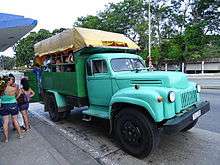
There are several national bus companies in Cuba. Viazul operates a fleet of modern and comfortable coaches on longer distance routes designed principally for tourists. Schedules, prices, and ticket booking can be done online, at any of the major international airports or National Terminals across Cuba. There are also other bus lines operated by tourism companies.
AstroBus, a bus service in Cuban National Pesos, designed to bring comfortable air-conditioned coaches to Cuban locals at an affordable price. The AstroBus lines operate with modern Chinese YUTONG buses, and are accessible to Cuban Residents of Cuba with their ID Card, and is payable in Cuba Pesos. Routes that have benefited most so far are those from Havana to each of the 13 provincial capitals of the country.
Urban buses
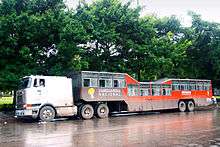
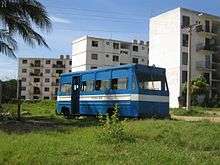
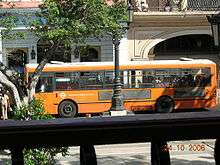
In Havana, urban transportation used to be provided by a colorful selection of buses imported from the Soviet Union or Canada. Many of these vehicles were second hand, such as the 1500 decommissioned Dutch buses that the Netherlands donated to Cuba in the mid-1990s as well as GM fishbowl buses from Montreal. Despite the United States trade embargo, American-style yellow school buses (imported second-hand from Canada) are also increasingly common sights. Since 2008, service on seven key lines in and out of the city is provided by Chinese Zhengzhou Yutong Buses. These replaced the famous camellos ("camels" or "dromedaries", after their "humps") trailer buses that hauled as many as two hundred passengers in a passenger-carrying trailer.
After the upgrading of Seville's public bus fleet to CNG-powered vehicles, many of the decommissioned ones were donated to the city of Havana. These bright orange buses still display the name of Transportes Urbanos de Sevilla, S.A.M., their former owner, and Seville's coat of arms as a sign of gratitude.[7] Seville
In recent years (2016), urban transport in Havana consists entirely of modern Yutong diesel buses. Seville and Ikarus buses are gone.
Automobiles
Since 2009, Cuba has imported sedans from Chinese automaker Geely to serve as police cars, taxis and rental vehicles.[8] Previously, the Soviet Union supplied Volgas, Moskvichs, and Ladas, as well as heavy trucks like the ZIL and the KrAZ;[9] and Cuba also bought cars from European and Asian companies. In 2004, it was estimated that there were some 173,000 cars in Cuba.[10]
Old American cars in Cuba
Most new vehicles came to Cuba from the United States until the 1960 United States embargo against Cuba ended importation of both cars and their parts. As many as 60,000 American vehicles are in use,[11] nearly all in private hands. Of Cuba's vintage American cars, many have been modified with newer engines, disc brakes and other parts, often scavenged from Soviet cars, and most bear the marks of decades of use.[12] Pre-1960 vehicles remain the property of their original owners and descendants, and can be sold to other Cubans providing the proper traspaso certificate is in place.
However, the old American cars on the road today have "relatively high inefficiencies" due in large part to the lack of modern technology.[13] This resulted in increased fuel consumption as well as adding to the economic plight of its owners. With these inefficiencies, noticeable drop in travel occurred from an "average of nearly 3000 km/year in the mid-1980s to less than 800 km/year in 2000–2001".[14] As the Cuban people try to save as much money as possible, when traveling is done, the cars are usually loaded past the maximum allowable weight and travel on the decaying roads, resulting in even more abuse to the already under maintained vehicles.[15]
Hitchhiking and carpooling
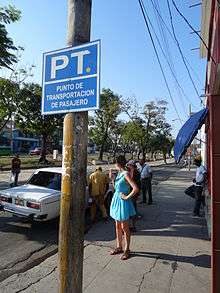
As a result of the "Special Period" in 1991 (a period of food and energy shortages caused by the loss of the Soviet Union as a trading partner), hitchhiking and carpooling became important parts of Cuba's transportation system and society in general. In 1999, an article in Time magazine claimed "In Cuba[...] hitchhiking is custom. Hitchhiking is essential. Hitchhiking is what makes Cuba move."[16]
Changes in the 2000s
For many years, Cubans could only acquire new cars with special permission.
In 2011, the Cuban government legalized the purchase and sale of used post-1959 autos. In December 2013, Cubans were allowed to buy new cars from state-run dealerships - previously this had not been permitted.[17][18]
In 2020, this was further extended with cars being sold in convertible currencies.[19]
Waterways
Ports and harbors
Merchant marine
- Total: 3 ships
Ships by type
- Cargo ships (1)
- Passenger ship (1)
- Refrigerated cargo ships (1)
- Registered in other countries: 5
Airlines
Besides the state owned airline Cubana (Cubana de Aviación), the two other major Cuban airlines are Aero Caribbean and Aerogaviota, both of whom operate modern European and Russian aircraft. One other airline is Aerotaxi.
Airports
- 133
Airports with paved runways
- total: 64
- over 3,047 m: 7
- 2,438 to 3,047 m: 10
- 1,524 to 2,437 m: 16
- 914 to 1,523 m: 4
- under 914 m: 27
Airports with unpaved runways
- total: 69
- 914 to 1,523 m: 11
- under 914 m: 58
See also
Gallery
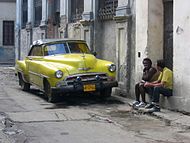 1952 Chevrolet in Havana
1952 Chevrolet in Havana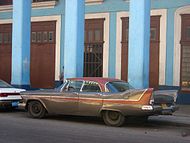 1958 Plymouth Belvedere in Havana
1958 Plymouth Belvedere in Havana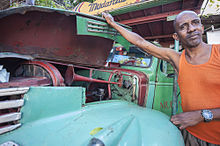 Antique Ford Truck, Jan 2014
Antique Ford Truck, Jan 2014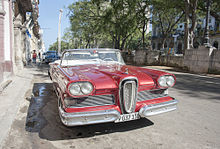 Edsel Pace in Havana, Jan 2014
Edsel Pace in Havana, Jan 2014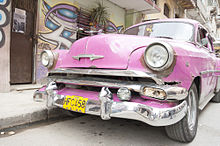 Pink Chevy, Jan 2014
Pink Chevy, Jan 2014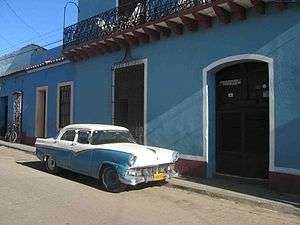 1956 Ford in Trinidad, Cuba.
1956 Ford in Trinidad, Cuba.
References
- (2003)
- "Cuba takes first step in railways upgrade with Chinese, Russian help". Reuters. July 13, 2019. Retrieved January 31, 2020.
- "New trains will start operating in Cuba with lower prices than for buses". OnCubaNews. July 9, 2019. Retrieved January 31, 2020.
- See: es:Red del ferrocarril suburbano de La Habana and File:Esquema ferrocarril habana.png
- "The tramways of Cuba" by Allen Morrison: Infos, maps, pictures.
- Source: Mapa de Carreteras de Cuba (Road map of Cuba, including the roads officially classified as Autopistas). Ediciones GEO, Havana 2011 - ISBN 959-7049-21-X
- The last lot was delivered in 2006: "Entrega de 16 autobuses de TUSSAM a la Habana como gesto solidario" Archived 2007-09-26 at the Wayback Machine, nota de prensa del Ayuntamiento de Sevilla
- http://caristas.blogspot.com/2011/01/geely-prounced-jee-lee-or-in-cuba-heely.html
- http://caristas.blogspot.com/2010/12/kraz-king-kong-of-trucks.html
- 16. Marcus Enoch, et al. "The Effect of Economic Restrictions on Transport Practices in Cuba". Transport Policy 11 (2004): 70.
- Schweid, Richard (2004). Che's Chevrolet, Fidel's Oldsmobile : on the road in Cuba ([Online-Ausg.]. ed.). Chapel Hill: University of North Carolina Press. p. 9. ISBN 978-0807828922.
- Schweid, Richard. Che's Chevrolet, Fidel's Oldsmobile (On the Road in Cuba). Chapel Hill, London. University of North Carolina Press, 2004. ISBN 0-8078-2892-0 p.196
- 12. James P. Warren, Marcus P. Enoch, "Mobility, energy, and emissions in Cuba and Florida". Transportation Research Part D: Transport and Environment 11 (2006): 35.
- 13. Warren and Enoch, "Mobility, energy, and emissions in Cuba and Florida", 35.
- 14. Warren and Enoch, "Mobility, energy, and emissions in Cuba and Florida", 35.
- http://www.time.com/time/magazine/article/0,9171,36287,00.html#ixzz1Ch67vm4p
- https://www.bbc.com/news/world-latin-america-15115004
- https://www.bbc.com/news/world-latin-america-25450026
- https://www.reuters.com/article/us-cuba-cars/cash-starved-cuban-state-sells-used-cars-for-dollars-for-first-time-idUSKBN20J2E6
External links
| Wikimedia Commons has media related to Transport in Cuba. |
.svg.png)